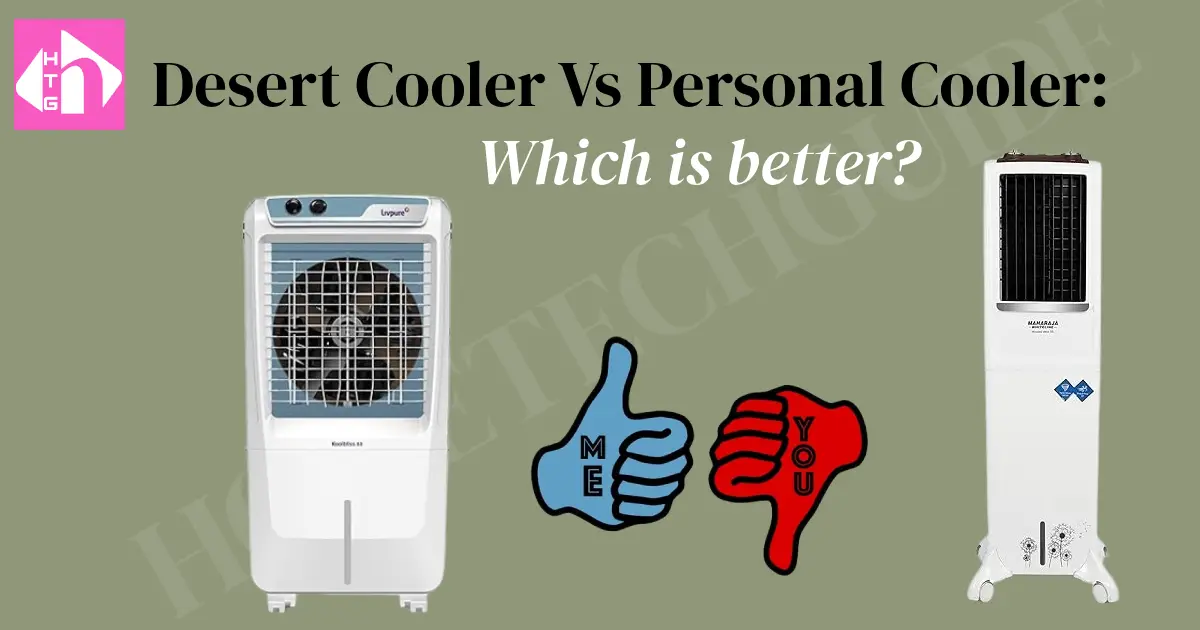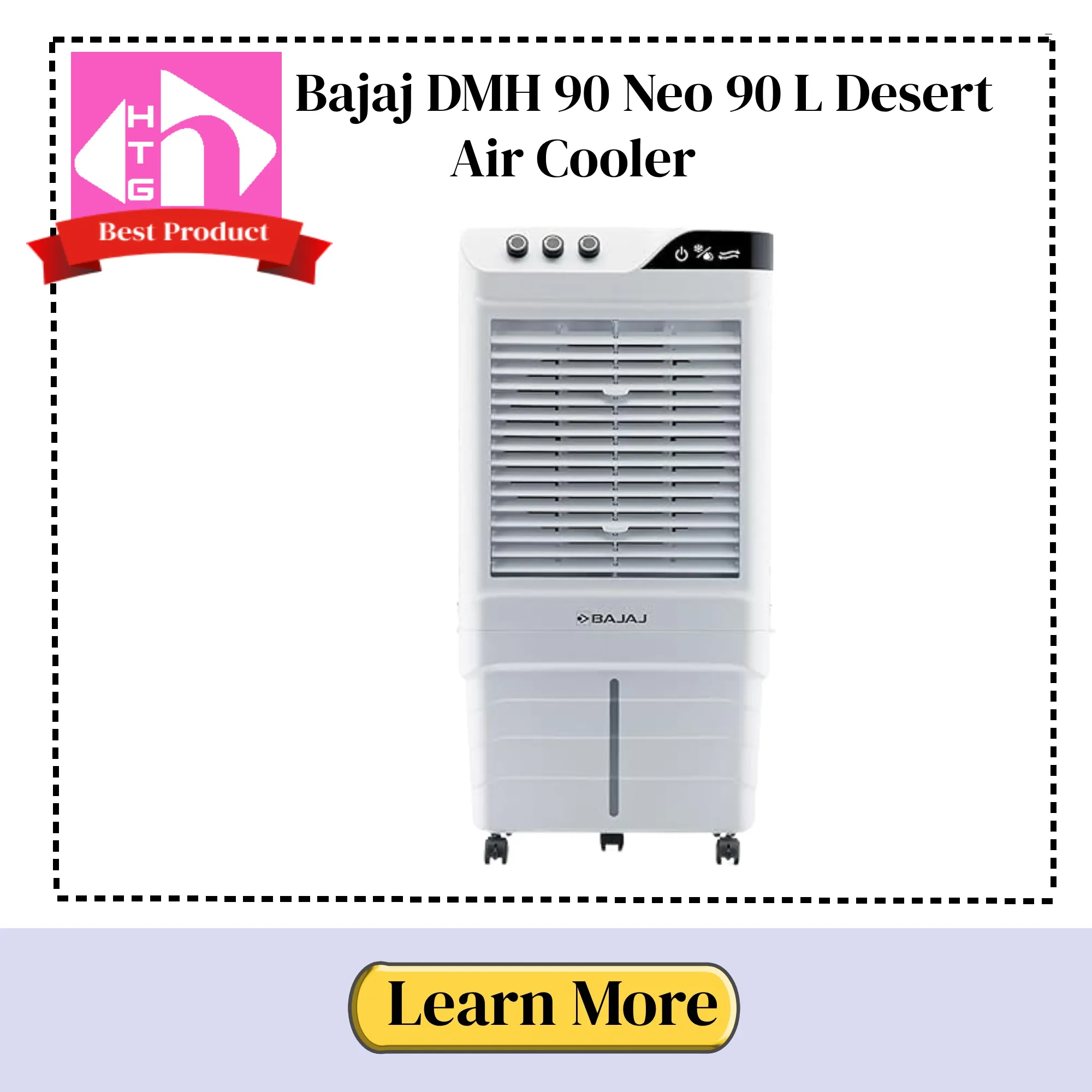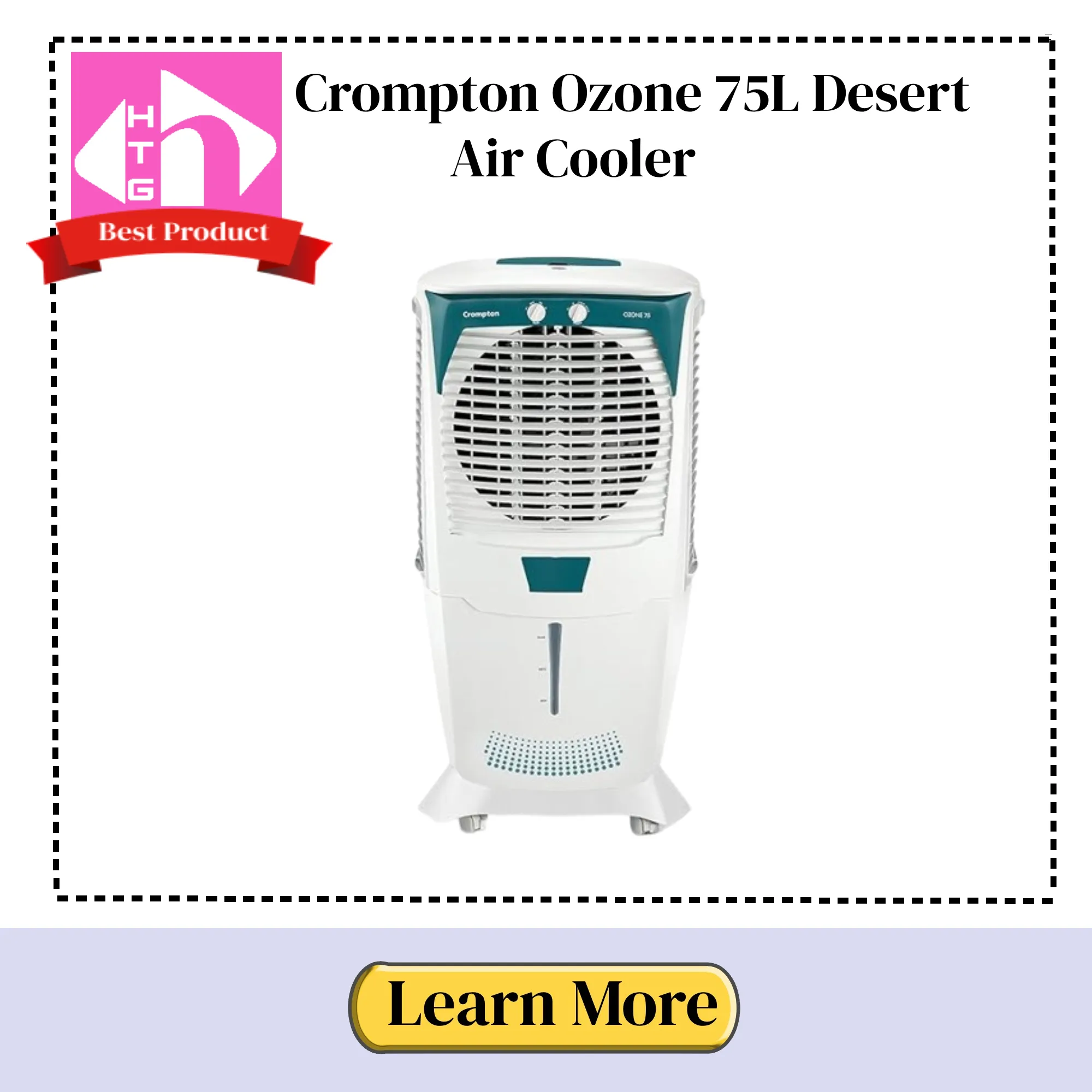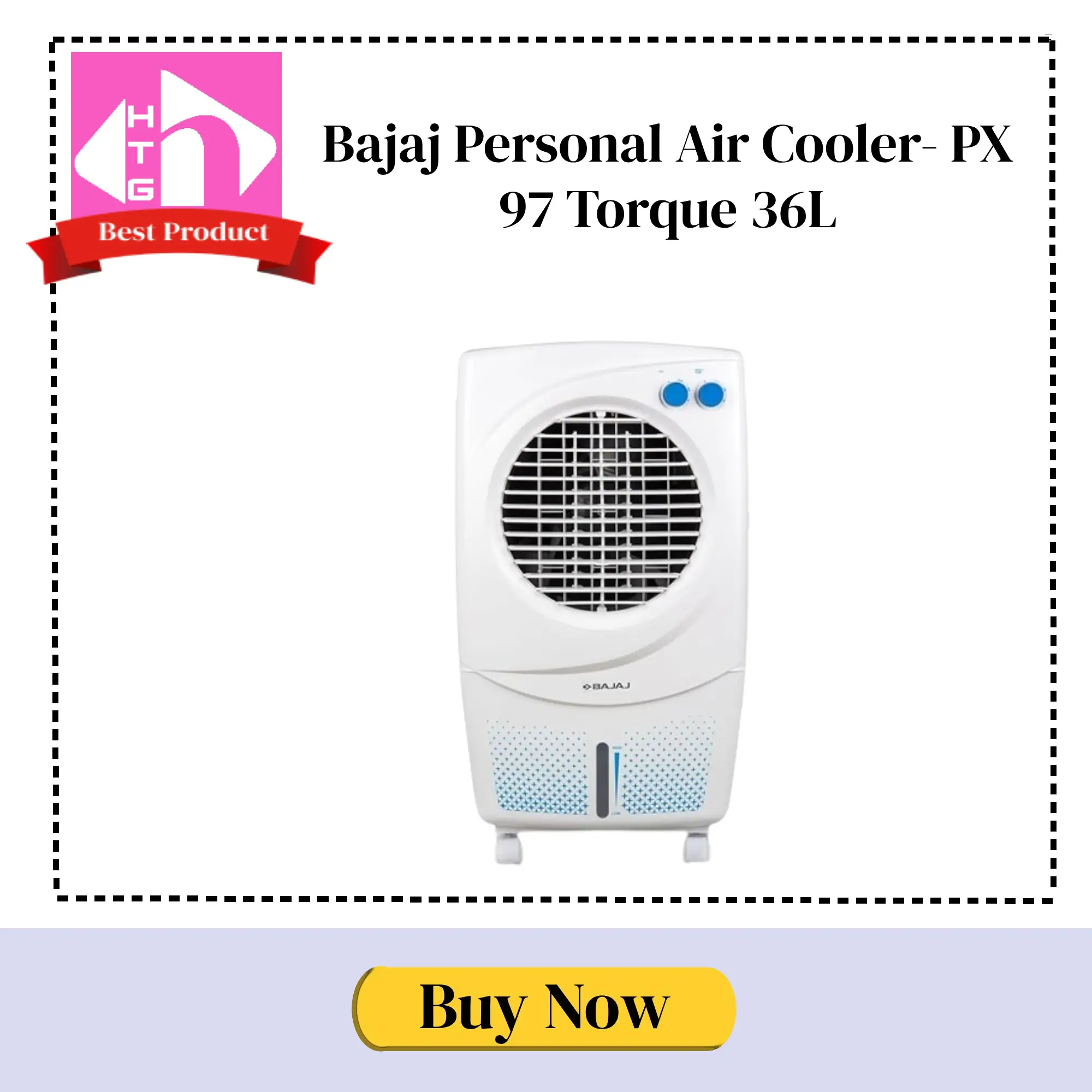Keeping cool in summer is a top priority and air coolers can be effective tools for attaining maximum cooling while saving on the bills. Desert coolers and Personal coolers are two popular choices, selecting one that suits your purpose of use can be tricky. Dissecting Desert Cooler vs Personal Cooler can help get insights into their application and buy the right one.

Let’s begin with an overview of the difference between a desert cooler and a personal cooler. Further, we will discuss their advantages and disadvantages. Before concluding with a tabled comparison of desert cooler vs personal cooler, we will look at some best-selling air coolers of each type to help you in your buying decisions.
What is the difference between a Desert Cooler and a Personal Cooler?
Each has unique benefits for different needs and spaces. A desert cooler is great in hot, dry places; it adds moisture as it cools the air through water evaporation. Personal coolers are similar but made for smaller areas while providing added portability – they’re ideal companions in close quarters or single rooms.
None works effectively in humidity contents greater than 60%, but personal coolers can be used as blowers, keeping the water pump off. This can also be tried with desert coolers but for a smaller fraction of the time. Using the desert coolers as blowers would create skin drying issues, or body pain because of their large throw volume.
Let’s understand each with their advantages and downsides, one by one.
Understanding Desert Coolers
Desert air coolers thrive in hot and dry settings. They harness water’s natural evaporating powers to chill the air. The strong fans of desert coolers pull hot dry air from outside. The dry air strikes the cooling pad, evaporating the water on the cooling pads to cool the room. Besides keeping the room cool, the desert coolers moisturise the space, making it perfect for arid zones where hydration matters as much as temperature drops.
Advantages of desert air coolers
- Desert coolers work effectively on hot summer days with low humidity.
- Desert coolers can cool large rooms efficiently.
- Desert coolers are energy efficient compared to air conditions. Broadly, they consume around 200 watts every hour while the ACs (Windows) consume 900 to 1400 watts an hour.
- Desert air coolers, because of the fewer moving parts, require less maintenance. They last for years with minimal hiccups, no need for frequent professional calls!
Disadvantages of Desert Air Cooler
- Desert coolers cool the room following the principle of evaporation. As such they require a large volume of water, and may not be suitable for areas with water availability issues.
- Desert Coolers do not work in areas with high humidity content. Instead, they make the room hot and humid.
- Desert Coolers cannot be used in closed rooms. The room should be properly ventilated to ensure efficient cooling.
Personal Coolers Explained
Personal coolers are like a friend you can count on when the sun’s out to get you. Smaller than desert coolers, these units work well in rooms for just one or two people. They’ve got water tanks that are big enough so users need not run back and forth to fill it every few hours – usually holding around 20-30 litres.
It works similarly to desert air coolers and can give efficient cooling if placed near the windows. However, personal air coolers are designed to use room air and tame the temperature to cool smaller areas.
Advantages of Personal Cooling
The advantages of Personal air coolers are as follows:
- Personal air coolers are perfect for single individuals.
- Personal air coolers come at a lower buying price compared to the desert cooler
- Personal air coolers consume less electricity compared to desert air coolers.
- Personal air coolers come in various shapes and sizes, making them easily portable.
- Tower personal air coolers are built uniquely to cater for a larger height, making them perfect to serve top to bottom for a person sitting on a chair.
- Personal air coolers can be used as blowers with the water pumps kept off. Adding Ice in the ice chamber can deliver enhanced cooling efficiency.
Disadvantages of Personal Air Cooler
- Personal air coolers are designed to cool small spaces. They don’t cool the entire room.
- Cross ventilation is necessary for better cooling. However, they work better than desert coolers in confined spaces with minimal ventilation.
- Personal air coolers are not as effective as desert air coolers on hot summer days, or in high humidity conditions.
Let’s now dissect desert cooler vs personal cooler in the next section.
Desert Cooler Vs Personal Cooler
The major differences between the desert cooler and personal cooler are:
Size Difference
Desert coolers are larger and are ideal for cooling large rooms under dry climatic conditions. They work by cooling the entire space. Personal Coolers, on the other hand, are smaller in size, require less space for installation and can be used to cool small areas such as sleeping beds, or an area around a user.
Application Difference
Desert Coolers are ideal for use in extremely hot conditions with low humidity and give the best cooling if installed at windows. Desert coolers are powerful enough to suck the outside air and evaporate the water on the cooling pads to make the room cool.
Personal coolers too give good results if placed at windows, but not the way desert coolers would do. This is because personal air coolers have a small surface area for cooling pads and small fans to pull in the outside air.
Desert Cooler vs Personal Cooler Noise difference
Noise creation is obvious with moving fan blades, and it’s no different with air coolers.
The bigger the fan more the noise from it. While modern cooler brands take several measures to limit the noise from coolers such as using dampers, and enhanced blade designs, desert coolers produce more noise than personal coolers. The reason is prominent, personal air coolers have much smaller blades. Users should check noise ratings before buying one.
Desert Cooler Vs Personal Cooler Energy Consumption
Energy consumption by air coolers depends on their sizes. The bigger the air cooler more power it will consume. This implies that Desert air coolers consume more energy per hour than Personal air coolers. But sometimes, the difference can be insignificant. Users should compare energy consumption ratings with various brands, even in one specific cooler type, before buying one.
Usually, air coolers for home consume between 150 watts to 300 watts an hour. Desert coolers take the higher side of this range while personal air coolers the lower side.
Desert Cooler vs Personal Cooler: Which is better?
| Desert Cooler | Personal Cooler |
|---|---|
| Cover large areas for cooling | Suitable for smaller areas only |
| Cools the entire room | Designed to cool only a fraction of the room |
| Consumes more power | Consumes less power |
| Consume more water | Consume less water compared to desert coolers |
| Produces more noise compared to personal air coolers, but within a permissible limit | Produces less noise |
| Can be used as a blower with the water pump switched off but for a small fraction of time. Usually, not recommended. | Can be used without water as a blower. |
Which one to buy: a Desert Cooler or a Personal Cooler?
Here are a few vital considerations and recommended settings to select the right air cooler.
Space you need to cool
It’s vital to consider the space you need to chill. For small rooms, a table or desk a mini 4-inch model can be just right; plug it in and feel instant relief from heat. When bigger areas call for cooling, tower fans fit perfectly without taking up much room.
Personal coolers are another step up and suit single users wanting more than what fans offer but aren’t ready for desert coolers yet – these work well where airflow needs control.
Yet if broad coverage matters most because of high dry heat outside, go with a desert cooler which taps into water evaporation principles so effectively that they drop temperatures significantly over large spaces compared to pedestal or personal options.
Air Movement
Air movement differs between devices: axial types found in many household items create gentle breezes while centrifugal ones pack more power.
Bonus Tips
Once clear with the purpose of use, study the various capacities to find one that suits your requirements. For instance, a desert cooler with an 80L capacity would serve a full night efficiently, eliminating any need to fill it twice at night.
Remember, the right choice hinges on your needs: room size, humidity levels plus how you maintain and use your air cooler.
Best selling Desert Coolers
Best Selling Personal Air Cooler
Tips for Maintaining an Air Cooler
- Desert coolers need regular water refills and their pads must be clean for optimal performance; this ensures they effectively lower temperatures in large spaces like banquet halls.
- Personal coolers demand less upkeep due to their size but still require water top-ups and occasional cleaning – perfect for single users seeking relief from the heat.
- Clean up before peak summer hits hard so that when warm waves roll through, you stay comfortable without breaking much sweat over cooler care.
Now, between personal coolers or desert ones lies a choice grounded on space size plus crowd count within rooms you wish to chill. As both leverage evaporation’s power — pulling warm air across cold water — it comes down to your specific situation which decides the best fit: mobility of small units versus stationary might of larger devices catering to crowds. It pays off keeping them well maintained too; dusty pads or low-water levels throttle efficiency fast!
Conclusion
While the air conditions lie in a similar zone, concluding which option is better becomes tricky between Desert Coolers and Personal coolers. This article focused on this aspect– pointing out the difference between desert coolers and personal coolers. The idea was to explain the concepts of both these coolers with their benefits and downsides and conclude with a desert cooler vs personal cooler table stating the differences as pointers.
Hope you find it helpful. If so, please share it with your friends.
Thank you!




